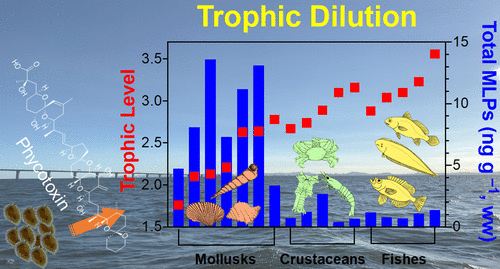当前位置:
X-MOL 学术
›
Environ. Sci. Technol.
›
论文详情
Our official English website, www.x-mol.net, welcomes your
feedback! (Note: you will need to create a separate account there.)
Occurrence and Trophodynamics of Marine Lipophilic Phycotoxins in a Subtropical Marine Food Web
Environmental Science & Technology ( IF 10.8 ) Pub Date : 2021-06-18 , DOI: 10.1021/acs.est.1c01812 Jing Li 1, 2, 3 , Yuefei Ruan 1, 2, 3 , Yim Ling Mak 1 , Xiaohua Zhang 4 , James C W Lam 4 , Kenneth M Y Leung 1, 2 , Paul K S Lam 1, 2, 3, 5
Environmental Science & Technology ( IF 10.8 ) Pub Date : 2021-06-18 , DOI: 10.1021/acs.est.1c01812 Jing Li 1, 2, 3 , Yuefei Ruan 1, 2, 3 , Yim Ling Mak 1 , Xiaohua Zhang 4 , James C W Lam 4 , Kenneth M Y Leung 1, 2 , Paul K S Lam 1, 2, 3, 5
Affiliation

|
Marine lipophilic phycotoxins (MLPs) are produced by toxigenic microalgae and cause foodborne illnesses. However, there is little information on the trophic transfer potential of MLPs in marine food webs. In this study, various food web components including 17 species of mollusks, crustaceans, and fishes were collected for an analysis of 17 representative MLPs, including azaspiracids (AZAs), brevetoxins (BTXs), gymnodimine (GYM), spirolides (SPXs), okadaic acid (OA), dinophysistoxins (DTXs), pectenotoxins (PTXs), yessotoxins (YTXs), and ciguatoxins (CTXs). Among the 17 target MLPs, 12, namely, AZAs1–3, BTX3, GYM, SPX1, OA, DTXs1–2, PTX2, YTX, and the YTX derivative homoYTX, were detected, and the total MLP concentrations ranged from 0.316 to 20.3 ng g–1 wet weight (ww). The mean total MLP concentrations generally decreased as follows: mollusks (8.54 ng g–1, ww) > crustaceans (1.38 ng g–1, ww) > fishes (0.914 ng g–1, ww). OA, DTXs, and YTXs were the predominant MLPs accumulated in the studied biota. Trophic dilution of the total MLPs was observed with a trophic magnification factor of 0.109. The studied MLPs might not pose health risks to residents who consume contaminated seafood; however, their potential risks to the ecosystem can be a cause for concern.
中文翻译:

亚热带海洋食物网中海洋亲脂性藻毒素的发生和营养动力学
海洋亲脂性藻毒素 (MLP) 由产毒微藻产生并导致食源性疾病。然而,关于 MLPs 在海洋食物网中的营养转移潜力的信息很少。在本研究中,收集了包括 17 种软体动物、甲壳类动物和鱼类在内的各种食物网成分,用于分析 17 种代表性 MLP,包括氮杂螺酸 (AZAs)、短毒素 (BTX)、金线虫 (GYM)、螺内酯 (SPX)、酸 (OA)、甲壳类毒素 (DTXs)、果胶毒素 (PTXs)、yessotoxins (YTXs) 和雪卡毒素 (CTXs)。在 17 个目标 MLP 中,检测到 12 个,即 AZAs1-3、BTX3、GYM、SPX1、OA、DTXs1-2、PTX2、YTX 和 YTX 衍生物 homoYTX,总 MLP 浓度范围为 0.316 至 20.3 ng g –1湿重(ww)。平均总 MLP 浓度通常降低如下:软体动物 (8.54 ng g –1 , ww) > 甲壳类动物 (1.38 ng g –1 , ww) > 鱼类 (0.914 ng g –1 , ww)。OA、DTX 和 YTX 是研究生物群中积累的主要 MLP。观察到总 MLP 的营养稀释,营养放大系数为 0.109。研究的 MLP 可能不会对食用受污染海鲜的居民构成健康风险;然而,它们对生态系统的潜在风险可能令人担忧。
更新日期:2021-07-06
中文翻译:

亚热带海洋食物网中海洋亲脂性藻毒素的发生和营养动力学
海洋亲脂性藻毒素 (MLP) 由产毒微藻产生并导致食源性疾病。然而,关于 MLPs 在海洋食物网中的营养转移潜力的信息很少。在本研究中,收集了包括 17 种软体动物、甲壳类动物和鱼类在内的各种食物网成分,用于分析 17 种代表性 MLP,包括氮杂螺酸 (AZAs)、短毒素 (BTX)、金线虫 (GYM)、螺内酯 (SPX)、酸 (OA)、甲壳类毒素 (DTXs)、果胶毒素 (PTXs)、yessotoxins (YTXs) 和雪卡毒素 (CTXs)。在 17 个目标 MLP 中,检测到 12 个,即 AZAs1-3、BTX3、GYM、SPX1、OA、DTXs1-2、PTX2、YTX 和 YTX 衍生物 homoYTX,总 MLP 浓度范围为 0.316 至 20.3 ng g –1湿重(ww)。平均总 MLP 浓度通常降低如下:软体动物 (8.54 ng g –1 , ww) > 甲壳类动物 (1.38 ng g –1 , ww) > 鱼类 (0.914 ng g –1 , ww)。OA、DTX 和 YTX 是研究生物群中积累的主要 MLP。观察到总 MLP 的营养稀释,营养放大系数为 0.109。研究的 MLP 可能不会对食用受污染海鲜的居民构成健康风险;然而,它们对生态系统的潜在风险可能令人担忧。











































 京公网安备 11010802027423号
京公网安备 11010802027423号